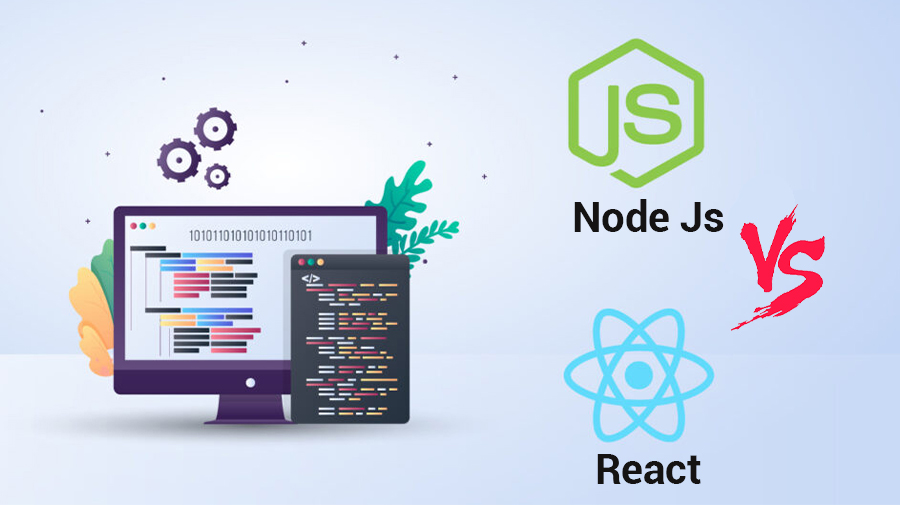Javascript is a popular programming language in today’s high-tech world, and choosing the proper one has always been a challenge for programmers. Node Js Vs React is the one that practically every Java programmer has heard of out of the bunch. However, they are two quite different technologies with which to use your Javascript project.
Picking the right one is very important for a programmer as a lot of their website or application’s future is dependent on it. As a matter of fact, a widely known streaming service, Netflix, once lost about two million dollars for choosing the wrong javascript which ended up crashing their server. So now you know how important choosing a compatible script is.

Let’s get started with the comparison.
What is Node Js?
To begin, keep in mind that Node Js is neither a framework nor a programming language. Node Js is mostly used to create the backend of applications, such as APIs, that employ Javascript. Node Js is fueled by Google Chrome’s V8, which, like most of them, is open-source and supports cross-platform runtime environments.

Ryan Dahl, the developer of Node Js, has made programmers’ lives easier by providing a tool for working in the non-blocking, event-driven I/O paradigm. Despite this, Node Js does not charge programmers anything and has committed to maintaining it that way in the future.
Windows, Linux, Unix, and Mac OS X are all supported by Node Js. Node Js users may create quick and scalable network applications because of their lightweight and high-efficiency rate. Furthermore, Js comes with a large library that makes it easier for programmers to create web apps.
Node Js is ideal for applications since it works in a single process and does not create new threads for each request.
Who is Node Js for?
If you’re just getting started with Javascript, Node Js is a great place to start. If you want to increase productivity while lowering development costs and remaining satisfied, Node Js is the way to go. The learning curve is the first of many.
Node Js has a smooth and simple learning curve when compared to other Java Scripts. Programmers don’t need to spend much time here because they’ve already completed more difficult processes, and it feels extremely natural to them, therefore reducing development costs.
The community is the second major incentive to switch to Node Js. Because it is an open-source platform, there is a large community here. Everyone strives to offer something new here, and everyone is kept up to date on the latest developments. As a result of being updated, programmers are constantly able to upgrade their apps for a better user experience.

Reusable materials are always available in the community, saving you time and effort in the future. Following the large community, Node Js gives its users a scalability edge. Because it employs single threads for non-blocking I/O calls, your website’s scalability improves dramatically.
Scaling, for the uninitiated, involves changing the canvas units horizontally and/or vertically. That is, you can add as much content as you want, and Node Js will let your application scale accordingly.
One of the main reasons streaming services like Netflix utilizes Node Js is because of its scalability. Aside from that, the performance of Node is another reason for them to use it. Because this javascript uses full stack javascript, the application is solely javascript from both the client and server sides, resulting in immediate responses.
If you’re not sure what you’re doing with your code, Unit Testing can help you out. Jasmine is the tool that is used to test your Node Js application from top to bottom. The finest part is that it isn’t reliant on anything or anyone, and it tests in its own way.
What is React?
The brand that created React inspires trust in you to use it because it is currently one of the most successful brands. React is a Facebook-developed Javascript-based user interface library. React Js is open-source, just like Node Js, and you’re probably already aware of the benefits of using an open-source package.

Moreover, React is known for having the biggest library in town. Unlike Node Js, React Js is more of a front-end library.
React is used to develop website User Interfaces, which means you have complete control over making your website seem exactly how you imagined it. React, on the other hand, is also used to develop layers of single-page interfaces in applications.
It is well-known for having reusable components, unlike most Javascripts. It allows you to simply drag and drop the component you just built and use it wherever you want without having to go through the hassle of creating it again and again.
Consider the Facebook website or any other social media website you prefer for easy understanding. There are always options for feedback, such as the comment option or the react option, where you can like or love the post. Apparently, that’s where the name comes from.
The ability of your browser to demonstrate that you have reacted to a website without having to reload it to interfere with your browsing is React Js’ magic.
React was first developed in 2011 and was first utilized on Facebook, and it is still being updated for the greatest experience to this day. Nonetheless, React’s goal has always been to keep things simple, fluid, and fast. They appear to have done a fantastic job.
Who is React for?
If you’re a Javascript coder, you’re probably sick of entering long pages of code to accomplish a simple task. If you want to get away from it, go to React quickly because it can perform the same thing in seconds.
Taking Javascript as an example, learning that language took some time and some people consider it difficult, but with the help of React, the learning curve cannot get any easier. It’s conceivable because of the simplicity, which is their primary goal, that even a 9-year-old child understands how it works.
The Javascript XML(JSX) syntax extension is another compelling reason to switch to react. Because the plugin combines JavaScript and HTML, you won’t have to waste time writing separate HTML and Javascript codes. It does, however, aid in the detection of important problems and hazards that you may wish to investigate.

The virtual DOM is what propelled React Js to the top of the list. You may use the virtual DOM feature to manage items on your website and application more efficiently. It works by storing a virtual representation of your website’s user interface in cache memory and updating it later with the real DOM.
The virtual DOM retains what was on the screen immediately before you made a change, such as reacting or commenting on a post, and then compares it to the real DOM and pastes that specific modification into it.
A website may need the placement of a specific button or any other component of the webpage or application on a different page. Now the button or component may be required to display the same button with different wording and outcomes. In this case, React Js’ reusable component comes in helpful.
A component can be copied and pasted, as we generally do. With a few clicks, you may place the component wherever in the User Interface. So, if your website requires certain buttons to be placed in different Interfaces, as most websites do, React Js is an excellent place to start.
Node Js Vs React: What is the Difference?
Let’s look at React vs Node js now that you’ve learned the concepts of both React and Node js. As previously stated, understanding the differences between these two can be extremely important because your website or application will be heavily reliant on them.
Don’t get us wrong: they’re both adequate, but you wouldn’t go to a Neurologist for stomach discomfort, and choosing which Javascript is an expert in a specific task will help you lay a solid foundation.
If you’re seeking a script that’s easier to learn, Node Js has overtaken React Js. Both are among the simpler to learn, but Node comes out on top when compared. However, implementing a web application with Node Js is tough due to the asynchronous programming that performs the non-blocking code.
React Js, on the other hand, React Js offers the most basic User Interface, which is straightforward to comprehend and will look quite familiar to programmers. Additionally, because it supports the JSX functionality, it is easier to develop online apps.
In terms of resources, React Js is unquestionably the winner. Both are open-source. However, because the React js community is larger than that of Node, more individuals contribute to keeping React up to date. React Js is likewise backed by Facebook, and React Js benefits from its popularity in a way that Node does not.
The React library is growing at a rapid pace, and there’s no way to keep up with the new widgets that appear every day.
Coming to the main point, the characteristics and their uniqueness. Because of its non-blocking activities, Node Js is a performance booster for your future project. On the other hand, React improves performance by utilizing a virtual DOM. In terms of performance, they are both in a competitive position.
Because React is backed by Facebook, it has access to the tools necessary for day-to-day coding. Debugging and design tools are available in React and serve as useful aid. Node Js, on the other hand, has a Jasmine tool. Jasmine assists you in testing your code and identifying any issues.
Now when you come to specialty, Node js is famous for its scalability. If you have a lot of content to provide then the scalability of Node comes in really handy as the horizon and vertical increase infinitely to keep up with your content.
React is the clear winner when it comes to mobile apps. React is now the easiest and finest way to create application user interfaces thanks to the reusable component feature.
Despite their identical code sizes, React and Node has differing managing capabilities. It’s more difficult to maintain track of the scripts for React’s sophisticated structure than it is for Node. React, on the other hand, wins when it comes to integration ease.
Node Js Vs React: Which One Wins?
In the battle of React vs Node js, it’s really hard to choose the winner when the two serve different purposes. Node js is the ideal choice if your project is fully content-based, like Netflix or blogs. It’s like it is built for it.

On the other hand, React is the best choice if you need dynamic input responses. That means that if your website’s state changes frequently, the virtual DOM will cover you.
Interestingly, keep in mind that you can combine the two into a single project. Node is a back-end framework, whereas React is a front-end framework. Working with both of them can open a lot of doors for you, and integrating them isn’t that tough.
Frequently Asked Questions
Since React and Node aren’t often compared, there are a lot of misconceptions among programmers. We’ve addressed a few common misunderstandings in the hopes of assisting you.
Is node JS full-stack?
Yes, Node js is a full-stack developer, which means you can create applications for both the client and the server.
Can I use React hooks next?
You can use React hook in Next Js but it’s a bit tricky to apply. We won’t recommend it to beginners.
Can I use node JS with Firebase?
Using Node Js with firebase hasn’t been easier. With just 6-7 steps, you can integrate the two.
How to store data in Firebase using react JS?
After integrating the two, you need to insert a few coding to store data in Firebase. We recommend going through a complete guide online.
Final Thoughts
To summarize, comparing Node Js Vs React is not a good idea. Both of them are standouts in their respective areas, and one will hardly lose against the other. You will not feel alienated or struggle alone because both of them have large communities that are always willing to assist with even minor problems.
If you’re working on a major project, keeping them in active combat isn’t the best option; instead, bring them together for greater results because they’re intended for various purposes. They were suited for one other because one works in the back and the another works in the front end.
If you were to select between the two, Node js offers more scalability and performance, whereas React js offers better rendering and tools.
